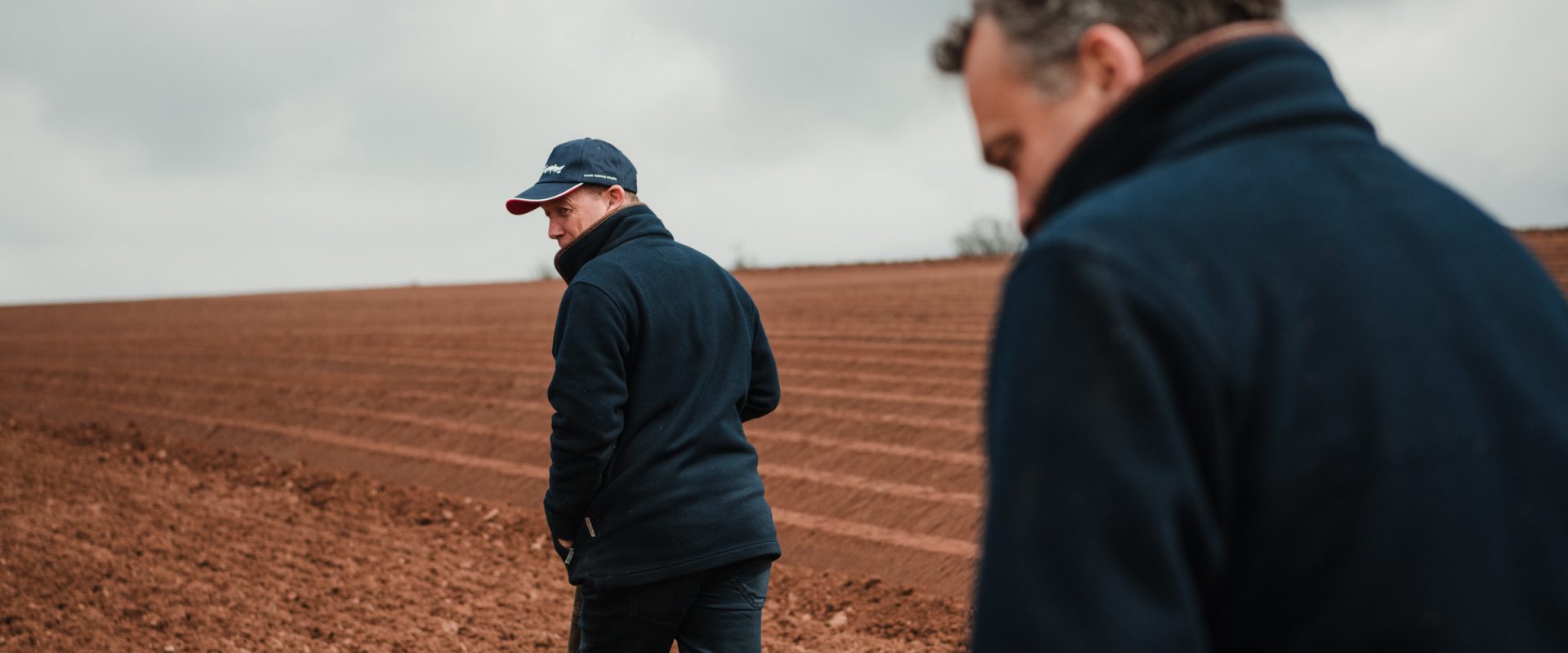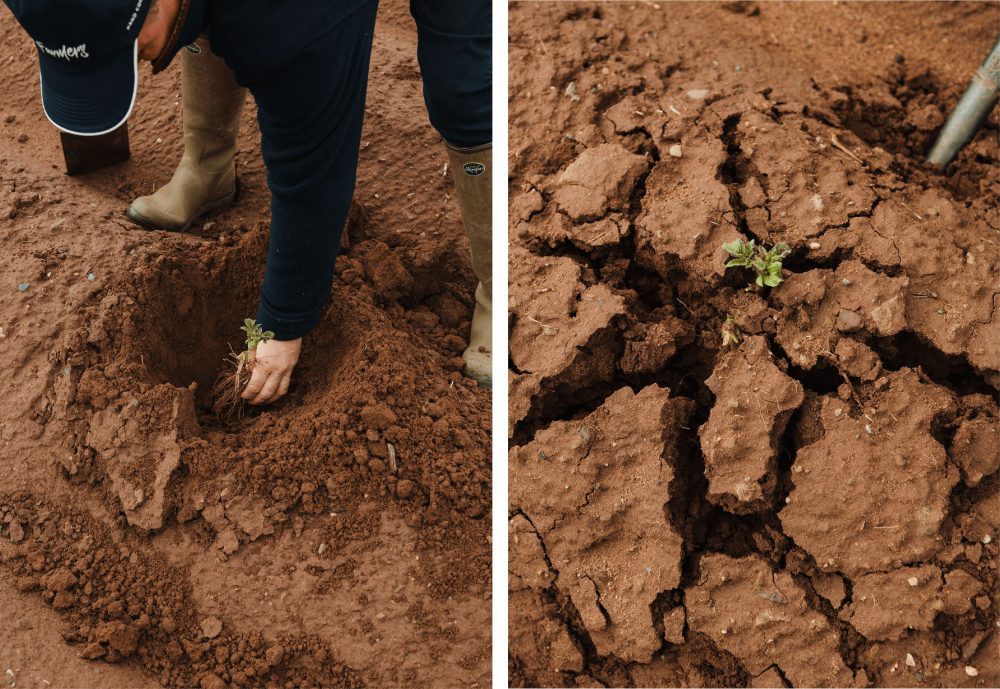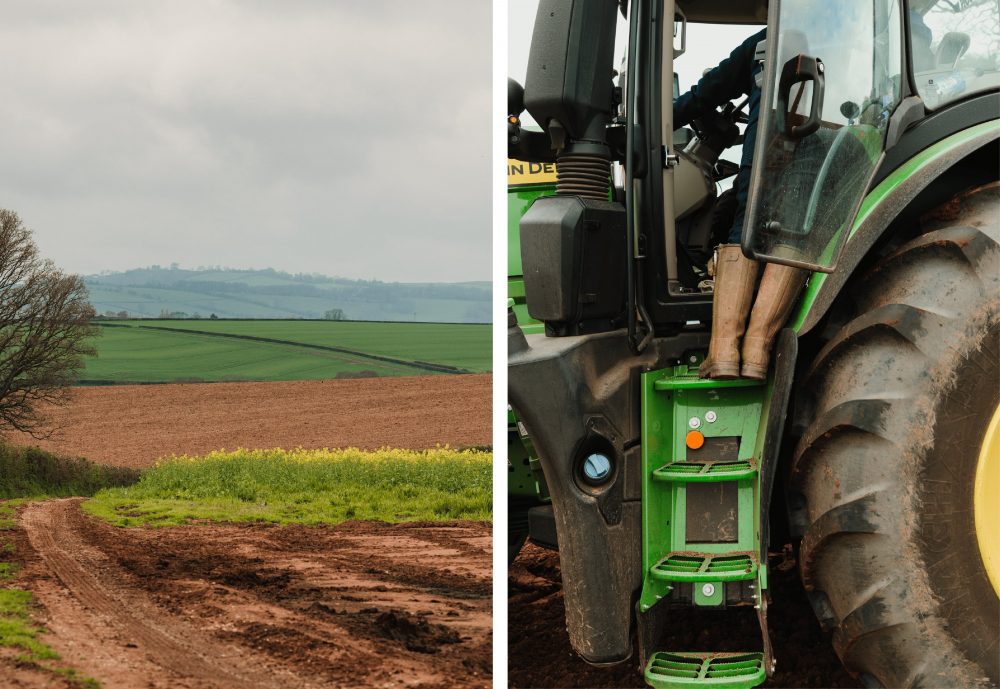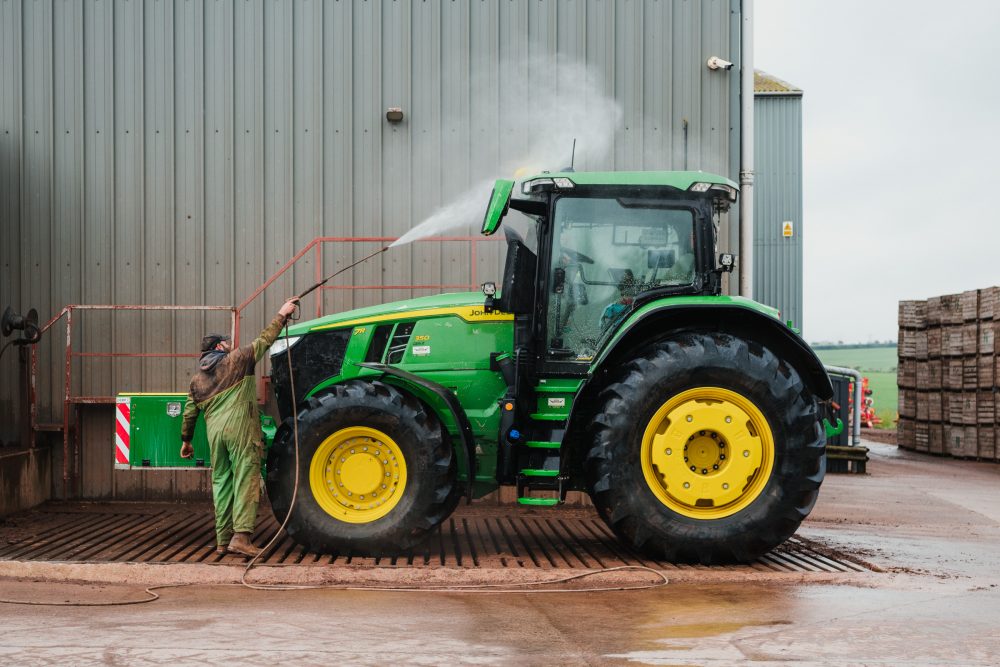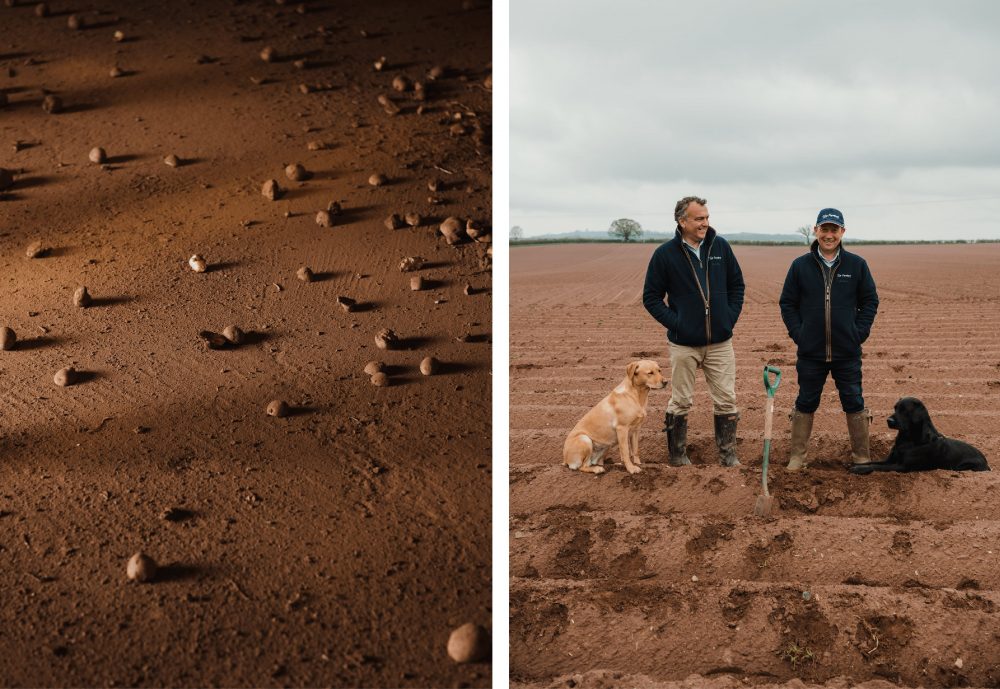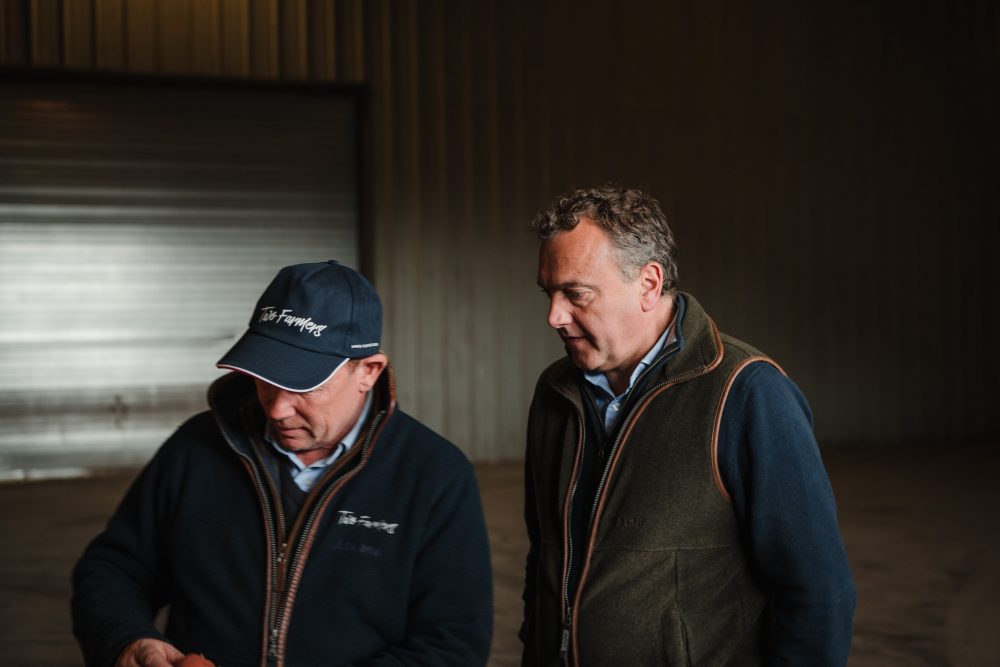Mark Green and Sean Mason are two farmers on a mission to work their fields in ways that ensure the land thrives for generations to come. We head to Herefordshire to see how the pair are getting their hands dirty – quite literally – to make it happen.
Farmer Mark Green puts seed potatoes into his well-looked-after soil.
We’ll get this out the way: Mark Green and Sean Mason, under the name Two Farmers, are the people behind the crisps you may have started to see in our bakeries. But this is not what this story is about, nor is the fact that their crisps are excellent the story behind why we work with them. For us, the right partner can’t only be about exceptional food – so much is a prerequisite. The true essence of why we collaborate with people like Green and Mason is because, in the face of plenty of opportunities to cut corners, they remain steadfastly resistant to the easy route, taking instead a path that’s more difficult, but which leads to somewhere much more worthwhile.
In Green and Mason’s case that path begins with the very ground we’re standing on. “Everything comes back to the soil, whether that be growing great produce, looking after biodiversity, or our aim to become carbon neutral. The soil is the one thing we’re not making more of and if we don’t look after it future generations will pay the price,” Green explains. Here, in a conversation that took place at the start of the growing season in Oak Meadow, a six-acre field on their farm, named for the single oak tree that stands proud in some of the finest arable land in England, Green and Mason tell us what drives them forward, from why their soil-first approach to farming is the right one, to why they didn’t give up on the idea of a compostable crisps packet despite a four-year battle to make it happen.
Mark and Sean, there are so many outputs of your work and so many things you seem to want to achieve, but if there was one thing you would define as your mission, what would it be?
Mark: “The soil is where we begin; it’s the most important part of the journey. I see myself as a keeper of the soil for generations to come, in the same way generations before looked after them. The difference is that previous generations probably didn’t know their ways of farming did such a good job of helping the soil! Modern farming has changed things so much, and we have to actively look after our soil now. Hopefully I will make them into a better state from when I found them.”
“Increasing the organic matter in the soil, which is what we’re really after, takes a generation – in farming terms that’s about 30 years.”
It’s a worthwhile cause. You said modern farming has changed things, so what does looking after soil look like today? How does technology play a role?
Mark: “You’ve got to start by walking out to the fields to pick up the soil, running it through your fingers and hands to get a feel for it. Then you can take it to a lab to see what it needs, and from there you can build up soil health in a couple of years. But increasing the organic matter in the soil, which is what we’re really after, takes a generation – in farming terms that’s about 30 years. When you increase organic matter in the soil it will drain better when it’s wet but retain moisture when it’s dry, so it will help at both extremes, plus it will have a lot more nutrients for the crops.
“We test the soil regularly and satellites scan the farm every week to give us information about how much canopy is growing, which, along with the colour of it, tells us how well the crops are growing, and if they need help. From those results we build a computer model that allows us to be very precise about only spreading fertiliser to the places that need it. So modern technology helps a lot in allowing us to understand our soil better, and how we can improve it.”
Pictured above, from left: The view of Herefordshire countryside from Oak Meadow field – “We don’t have a flat field on the farm,” says Green. Checking that the tractor is on track.
Satellite-guided farming, what next?! Surely it isn’t all science labs though, what lessons from the past can help with soil health today?
Mark: “The most important thing to go with the modern stuff is crop rotation, which has been practised forever. A lot of people don’t realise that you grow a crop of potatoes on the field once every five or six years, in the meantime you’re growing other crops, which rests the soil, and builds up organic matter – each crop will enhance it. If you grow the same crop constantly, you will build up resistance in the soil and eventually it will go stale. So, as well as potatoes, we grow winter wheat, winter oilseed rape, beetroot, and then all our energy crops like maise and sugar beet, all in a rotation around the farm.
“Rotating crops is standard practice, but you can only rotate as much as we do when you have the soil to do it. The soils in Herefordshire are famously productive; I can’t think of anything that grows in the UK that doesn’t grow here. So it would be a shame not to get the most out of them, while still ensuring they stay in good health.”
“I can’t think of anything that grows in the UK that doesn’t grow here”
Pictured above, clockwise from top left: A makeshift switch fashioned from old golf balls outside one of the farm buildings. Pallets stacked up at one of the farm buildings. A farm worker cleans his tractor – “They are very proud of their tractors,” says Mason.
You mentioned energy crops, what are those?
Sean: “We’ve been looking at how the farm could be kept as sustainably as possible for a long time. For us that meant figuring out how everything within the farm can be used in a circular process, to create its own energy, create its own fertilisers, and add back to the ground what is taken out.
“An anaerobic digester plant was a wonderful opportunity to do that. It’s basically a giant stomach: you put crops like sugar beets in and it turns them into energy we can use to power the farm, while the byproduct can be used as fertiliser.”
Mark: “It’s an ideal situation for us as farmers, and a lot of ideas for the crisps were born out of it. When we started, Sean and I realised what we were doing was adding value to the potatoes. We’ve got a fantastic site in the middle of Herefordshire for growing potatoes, we’ve got our own energy bank, and the next step was how do we fit a sustainable crisp into our farming business? It wasn’t a blueprint we followed, it evolved as we asked ourselves if we could be the first people to make crisps in this way.
“We would like in the next year or so to be carbon neutral and hopefully net zero. But we want to offset everything on the farm as we’re growing the crop; we don’t want to be outsourcing anything overseas. Never take the easy route!”
Pictured above, clockwise from top left: Potatoes at the on-site processing plant. Mason, left and Green, right, in Oak Meadow field, along with their dogs. The undulating fields of Herefordshire.
“It was almost an impossible task to try and change a crisp packet from a plastic bag.”
We like your thinking. So how exactly did the idea for the crisps come about?
Mark: “We’d been growing potatoes for other crisp makers for years, and wondered why we weren’t just doing it on our own. One Friday afternoon we were in the local pub putting the world to rights when we started to think about it more seriously.
Sean: “We knew we had great soil, great potatoes and fantastic local ingredients here in Herefordshire that could season the crisps, so it felt like playing to our strengths. What’s nice is that The Red Lion, where we first had a serious conversation about it, now only sells our crisps.”
That must be satisfying, especially given how long it took you to launch them. You said you never take the easy route – how did that play out when you decided you wanted to make crisps?
Sean: “The thing I was very strong on was moving away from plastic packaging. When we first thought of this back in 2013, plastic waste wasn’t such a big issue but we could see how much litter was dotted around the hedgerows, staying there forevermore.
“It took us four years to find compostable packaging and we very nearly gave up on it because it seemed as though we were trying to push water uphill. It was almost an impossible task to try and change a crisp packet from a plastic bag. But we did carry on and push through, and I think that all goes back to how the farm operates: what we are trying to do is make that whole thing sustainable from every angle we can.”
Green (left) and Mason (right) in one of their on-site storage warehouses, where potatoes are kept until they are sent to the frier.
“If we can be a source of local trade, then we are helping businesses thrive in Herefordshire, which we need to make the county work.”
It’s a shame that switching away from plastic is that difficult. But we’ve tried your crisps and we know from tasting them you’re efforts weren’t just on the bag! How did you approach the crisps themselves?
Mark: “Farmers in other parts of the country would laugh but Herefordshire isn’t the easiest place to farm. We haven’t got flat, 100-acre fields. Our average field is 25 acres; we’ve got hedges, we’ve got woodlands, we’ve got predators everywhere, the banks are sloppy. I don’t think we’ve got a flat field on the farm.
“We aren’t near any big processors, so if you want to sell your produce in Herefordshire, you’ve got to put it on a lorry and take it somewhere, which costs money, never mind the emissions. So what Sean and I try to do is support as many people locally as we can by sourcing ingredients for the crisps from nearby producers. If we can be a source of local trade, then we are helping businesses thrive in Herefordshire, which we need to make the county work.”
Sean: “But it also showcases what high-quality produce there is in Herefordshire that people wouldn’t know about. Thankfully we’ve been able to give some of them a platform to be seen across the whole country. And the delis around here love the fact they can have our crisps next to the actual salt we use from Droitwich Salt, who operate one of the oldest and cleanest brine springs in the world. It’s the same for the cheese we use from Charles Martell & Son, and the rare breed pork we use from Tudge Meats. And so instead of using generic ingredients that come from anywhere in the country, the crisps become an expression of Herefordshire.”
Mark: “The seasoning is one thing but then there’s also the texture of the crisps. We wanted a slightly less cutting mouthfeel than other hand-cooked crisps, and we think we got it right. Maximising quality begins with the freshest product, and our potatoes travel just a short distance to an on-site fryer. We actually hold the world record for field-to-shop crisp production at under 30 minutes! We batch fry for the ideal crispiness, and then season using a drum, whereas other crisps makers would use spray flavours on uniformly. Each bite is different, but that’s the attraction.”
Pictured above, from left: Crates of harvested potatoes are stored in temperature-controlled warehouses on the farm, powered by the on-site anaerobic digester. A pint and a packet of Two Farmers crisps in the local pub ends the working week for Green and Mason.
We think so too. Thank you guys, we love what you’re doing and we’re very proud to be working with you.
Sean: “Likewise. GAIL’s ethos of producing all your own food to the highest standard fits very well with what we’re doing. Looking at the businesses, although they are entirely different, there is definitely an ethos to try and achieve a similar thing at the end. It’s that understanding of not taking the easy road and not cutting corners, which would take away from the true fact of what you’re trying to do.”
Mark: “We’re excited about what’s next. We like the fact that GAIL’s are interested in coming to see where the products are grown and how the crisps are made, and we’ve spoken about growing wheat and grains too. These days there aren’t many people interested in putting on wellies and walking out to which exact fields their ingredients are grown in.”
